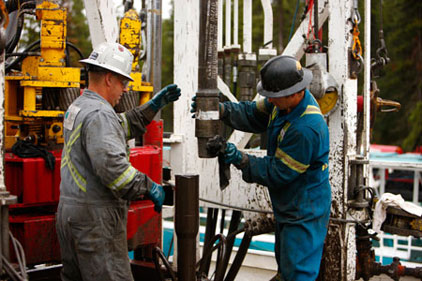Roughnecks (a term widely used in the oil and gas industry to describe oil-field workers) demand tough materials for equipment that must work around the clock in hostile environments. Delays or accidents stemming from equipment wear, malfunction or failure can have major implications.
in hostile environments. Delays or accidents stemming from equipment wear, malfunction or failure can have major implications.
Lost production can cost hundreds of thousands of dollars per well per day, and in some cases, ultimately lead to loss of the well and the millions of dollars invested. Just like in the aerospace or medical device industry, money is often no object; cost takes a back seat to quality, safety and performance.
Unlike more cost-conscious industries, such as automotive manufacturing, it’s not uncommon for oil and gas companies to say “How quickly can I get it? I don’t care what I have to pay.”
“Stainless steels and nickel-based alloys are heavily used by oil and gas equipment manufacturers, but they have a variety of welding challenges,” says Morgan Gallagher, PhD, an applications engineer with the materials group at EWI, who previously worked in the industry. “Titanium and copper alloys are also used, [but they pose issues, too]. For instance, titanium is a finicky metal to weld, because it oxidizes rapidly.
“As the oil and gas industry drills deeper and deeper, engineers are demanding higher-strength and higher corrosion-resistant materials,” adds Gallagher.
“Often, these materials do not have proven weldability.”
For instance, high-temperature drilling environments provide a unique set of challenges for down-hole equipment. “In many of these applications, the tungsten carbide insert roller cone bits used to drill must endure hard and abrasive formations to access steam or hot rock in basement formations where temperatures can exceed 500 F,” says Guy Arrington, president of bits and advanced technologies at Schlumberger.
“At that temperature, a standard 300 F-rated bit’s elastomer seals and lubricating material quickly degrades, causing bearing failure, resulting in operational inefficiencies,” Arrington points out. “Reduced on-bottom drilling hours leads to multiple bit runs and increased development costs.”
When engineers at Schlumberger’s Smith Bits division recently developed a new line of high-temperature roller cone drill bits, they were forced to use new
materials. “A new range of advanced materials were developed, combined with an engineered design solution, to deliver improved bit performance in these applications,” claims Arrington. “These innovations increase seal life, lubricity and load capacity at elevated temperatures.”
The seals of the Kaldera bits are made from fabric-reinforced fluoroelastomer composites to provide thermal stability and wear resistance. Engineers developed a grease compound from synthetic base oils and functional additives to increase load capacity at elevated temperatures and ensure adequate lubricity of the bearing sealing system.
Engineers at another leading oil and gas equipment manufacturer, Weatherford International Ltd., recently developed an expandable sand screen system for deepwater drilling applications. The device controls the influx of sand going into wellbores on the ocean floor. Constructed of a base pipe, filtration membranes and outer shroud, the system expands when a proprietary tool is pushed from the top down.
The engineers used a spinodally hardened copper nickel tin alloy supplied by Materion Corp. ToughMet 3 TS160U rod is used within the expansion tool for its high strength, corrosion resistance and low friction-bearing properties. It ensures that the components effectively slide to expand for contact with the wellbore, thus providing stability and controlling the influx of sand.
Alloy steel with Incolloy 825, Duplex is specified by engineers at Aker Solutions ASA for producing its range of subsea control modules. “Our equipment is designed for pressures up to 1035 bar and temperature ranges from -29 C to +177 C,” says Svein Oskar Nuland, managing director of Aker Solutions’ yard in Egersund, Norway, where the company assembles and tests Christmas trees, wellheads and other equipment. “Our subsea trees have successfully been qualified to water depths of 3,000 meters.”
The company’s GasBooster compression module houses a 16-foot high vertical centrifugal machine that operates at 11,000 rpm. “An innovative design of the compressor has reduced the number of moving parts and supporting systems,” claims Nuland. “For example, the bearings are magnetic and do not require a lubrication system and need only low-voltage power for their operation.”
The compressor and its high-speed electric drive motor are housed in a single, hermetically-sealed enclosure that is pressurized with a barrier system to keep the motor and compressor spaces separate. According to Nuland, the motor and bearings are cooled by process gas in a closed-loop with an external seawater heat exchanger. Variable-speed drives for the compressor and pump are controlled from shore by signals sent through fiber-optic cables.
Tough Conditions Demand Tough Materials

Looking for a reprint of this article?
From high-res PDFs to custom plaques, order your copy today!



